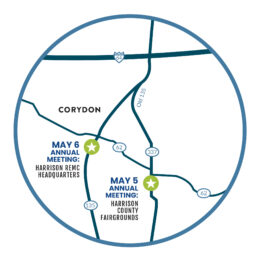
BOB
GESWEIN

It’s important that your home’s heat pump is correctly sized. The Manual J, Heat Loss/Heat Gain calculation should be used to determine the correct size. The calculation shows how much heat your home loses in the winter and how much it gains in the summer.
Southern Indiana’s climate makes this a great place to install and use air-to-air heat pump technology. But, Southern Indiana’s climate can also cause high winter electric bills when a home has an air-to-air heat pump.
Why would I say an air-to-air heat pump is a good system and at the same time acknowledge it can cause high winter electric bills? Let me explain the importance of having a heat pump correctly sized for your home.
HVAC contractors take information about your home and use it to do the Manual J, Heat Loss/Heat Gain calculation to determine the correct heat pump size. This calculation shows how much heat your home loses in the winter and what the new heat pump must replace. It also shows how much heat your home gains in the summer and how much the new heat pump must remove. These figures help the HVAC contractors determine which size unit is correct for your home. But, be aware: Your heat pump is sized using summer cooling criteria.
If the unit is correctly sized for the summer when it is 95 F outside, it will run an appropriate amount of time to cool the interior of your home and remove enough humidity to keep you comfortable. The humidity issue is a big deal. Don’t allow your HVAC contractor to install a heat pump bigger than the Manual J, Heat Loss/Heat Gain calculation recommends for summer cooling. If you do, the bigger unit will come on and quickly cool your home down, but will not run long enough to remove a sufficient amount of humidity to ensure your comfort and a healthier environment. Heat pumps that are too large will keep a home cool, but the humidity level will be high and your home will be more like a cellar in the summer — cool, but very humid. So, it is easy to see that in the summer when the outside temperature is 95 F and you want the inside of your home to be 75 F, your heat pump must deal with a 20-degree difference.
Winters in Southern Indiana are much colder than summers are hot, which is why most people have higher electric bills in winter than summer. It is not unusual for the outside temperature to go down to 25 F in our winter. The same heat pump that was sized for summer dealing with a 20-degree difference between inside and outside is now being asked to deal with a 50-degree difference between the inside comfort level of 75 F and the outside temperature of 25 F. The heat pump will be challenged to keep us as comfortable as we want on its own. Because of this, HVAC contractors install supplemental electric heat strips in the air handler that only come on when the heat pump cannot maintain 75 F as the inside temperature. This is an automatic operation and happens because we have told the HVAC contractor we want the home to be 75 F in the winter. A thermostat set in the automatic mode will maintain 75 F for you without any requirement from you to change it using both the heat pump and when needed, the heat strips.
Consider this: Heat strips cost three times more to operate than the heat pump. Some people may be more interested in saving money than maintaining 75 F in their home. To help lower your heating costs, ask your HVAC contractor to install a switch on the side of your air handler (some people refer to this as their furnace). By having this switch installed, you can turn the heat strips off and on as you want, not as the thermostat is automatically designed to do.
But the first thing people say when this is suggested is, “I will freeze to death in my home because I have been told that heat pumps don’t make heat below 30 F.” This is not true. Heat pumps continue to provide heat to your home as the temperature goes down, but since they actually get this heat from the outside air, the colder the air gets, the less Btus of heat are available and the heat pump must run longer. Longer run times are a good thing if your heat pump keeps your home comfortable without the heat strips coming on. Some HVAC employees are telling people that when the outside temperature gets down to 30 F they need to go to the thermostat and turn on the emergency heat. What this action does is turn off the efficient heat pump and turn on the expensive heat strips. They tell you this for their benefit, knowing the temperature will be warmer coming out of the registers and they will not have to make a visit to your home just to explain the operation of your heat pump. This should have been done when you bought the heat pump.
Heat pumps can produce heat well below outside temperatures of 30 F. But, you must know that as the temperature gets colder outside, your home will require more Btu of heat to stay warm inside. This means the heat pump will run longer (but still be cheaper than the heat strips) and at some point, may not be able to maintain the inside temperature of 75 F. Many people say they are willing for the temperature to go down to 72 or 70, and some even lower if they can keep their electric bill down.
Many people are surprised at how low the outside temperature can go and their heat pump still keeps them comfortable. With the thermostat set from the factory to operate automatically, we never fully challenge the heat pump to do as much as it can. But, be aware there will be days the outside temperature will be low, the wind will be blowing and it will be cloudy, and you may say, “This is too cool for me. I am too uncomfortable to stand this lower temperature.” You can then, at your own discretion, turn the switch on to operate the heat strips and warm your home up. It will cost you more but you will have made the decision yourself.
Homeowners who have taken my suggestion and installed this switch are surprised at how comfortable they still are most of the time and how little they actually have to turn on their heat strips. As a result, they have lowered their electric bill, which was their goal.
If you have questions, feel free to call me, and I will be glad to explain it over the phone. Call me at 812-738-4115 or 812-951-2323.
BOB GESWEIN is energy advisor at Harrison REMC.



